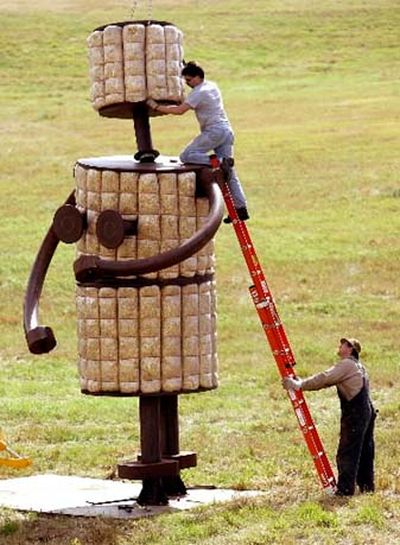At WSU, the art world is standing tall

For those of you heading down to Pullman on Saturday for the first Cougar home football game of the season, consider getting there before 10 a.m.
In addition to having plenty of time to set up your tailgate party before the matchup against Idaho, you’ll be able to take advantage of the free guided walking tours of the “Sculpture From the Walla Walla Foundry” outdoor exhibition.
Spread across the Washington State University campus, this extraordinary presentation of 13 large public art pieces coincides with an indoor museum exhibition of sculpture by internationally known artist Jim Dine.
Together the two shows constitute the most ambitious display of artwork in the history of the university.
“When I first came to WSU last year,” said museum director Chris Bruce, “Keith Wells, the museum curator, came to me and asked, ‘What do you think about doing a show with the Walla Walla Foundry?’ I said, ‘You’re kidding, it hasn’t been done yet?’ “
Within a few minutes Bruce was on the phone with Mark Anderson, founder of the famed fine arts foundry, asking for a meeting to talk about an exhibition.
Anderson started the Walla Walla Foundry in 1980 as a small operation in an old auto garage. Since then it has expanded to more than 30 workers on a four-acre site and is “the premiere foundry for modern artists on the West Coast,” said sculptor Tom Otterness. “A lot of famous artists cast there.”
“I enjoy my work immensely,” said Anderson. “My business is to supply a service for artists, and I’m fortunate to have great artists to work for, so our castings go to museums throughout the world.”
Works by nine of those artists are represented in this show, including the giant three-piece, 17-foot high sculpture “Makin’ Hay” by Otterness, of New York City and Havre, Mont.
Otterness, who also has a huge outdoor exhibit, “On Broadway,” in New York, is best known for creating cartoonlike, figurative sculptures of round, asymmetrical small people.
“The hay sculptures are different from what I typically do,” Otterness said during a telephone interview from the San Francisco airport.
“Two years ago I made them for the ‘What the Hay’ show near Utica, Mont., where hay bale sculptures are displayed in fields along the highway,” he said. “I only found out about the show about a month ahead of time and had the technical drawings to Walla Walla within a week.”
The foundry crew was up to the challenge.
“They must have work around the clock,” said Otterness. “They got all three of those pieces made and on a flatbed truck and out to the site within three weeks. It was a superhuman task.”
That same enthusiasm kicked in again when preparing for the WSU shows.
“Mark and his team were phenomenal in pulling this exhibition off for us,” said curator Wells. “They’ve offered their expertise, time and trucks. We could not have pulled it off without their help.”
Sculptures have rolled into Pullman from as far away as New York and California.
On loan from Central Washington University is Deborah Butterfield’s “Wickiup,” an expressive horse sculpture created from driftwood cast in bronze.
“Right now I’m looking down on Deborah Butterfield’s horse,” said Wells from his office in the Fine Arts Building, “and two people are looking at it and talking.
“They are having a conversation about a work of art. That’s exciting and adds tremendously to the university experience.”
One of the goals of the project is the possible acquisition of new public sculpture for permanent placement on the WSU campus.
“This is an opportunity for all of us to look at a critical mass of sculpture and get people’s reactions to it,” said Bruce.
“I tell people you try shoes on before you buy them. Why shouldn’t you try art on before you buy?”